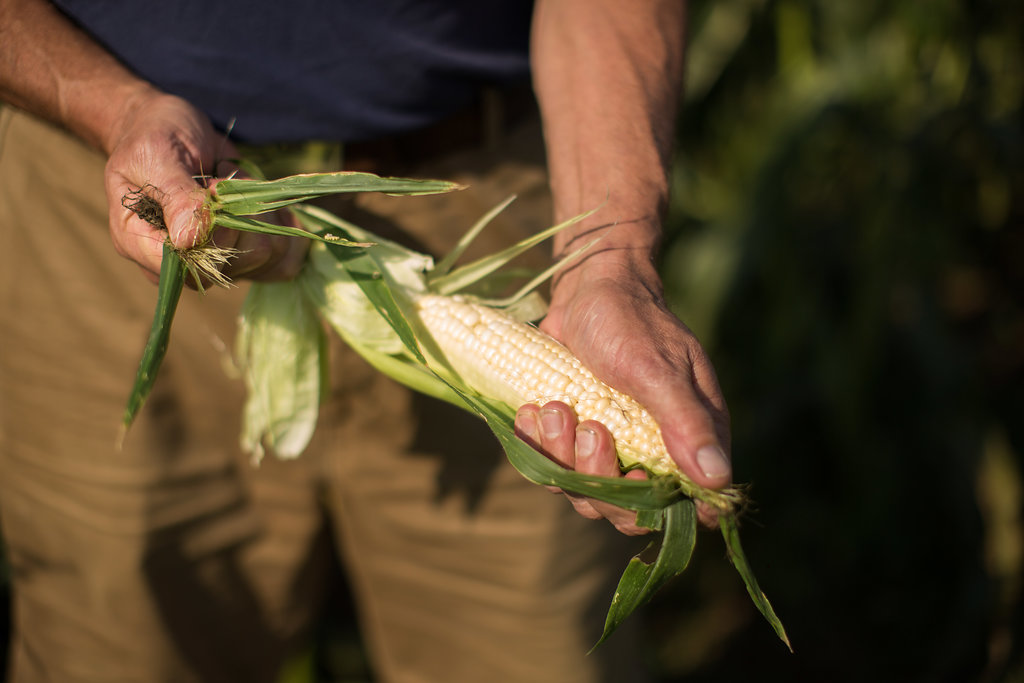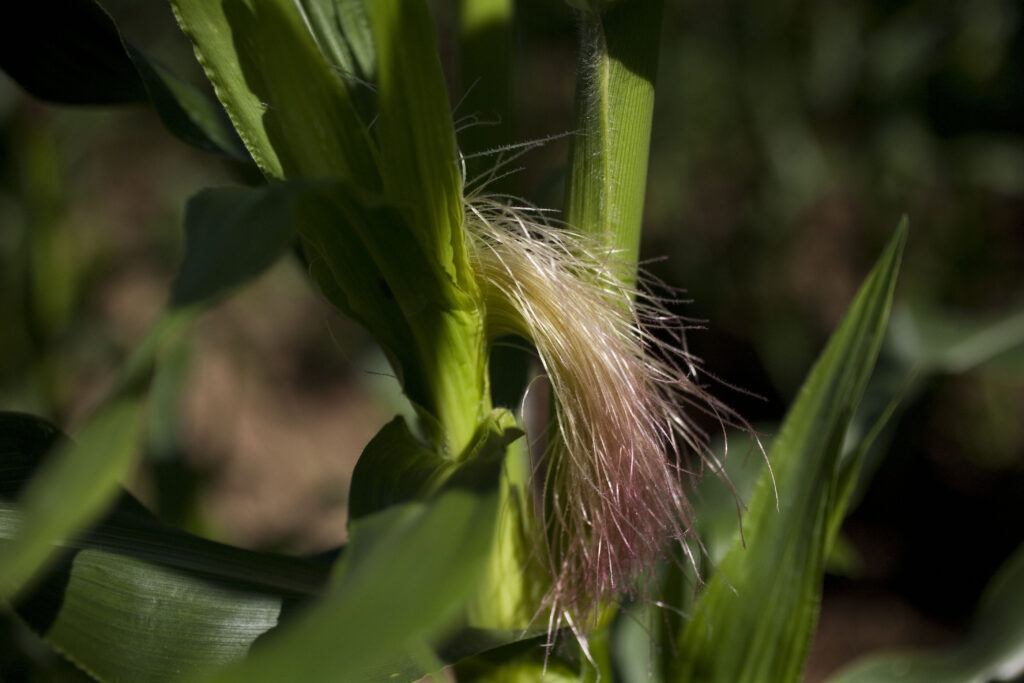Happy first day of organic Elmwood Stock Farm sweet corn! This is a celebration on the farm each year because sweet corn season is short and, oh, so sweet. Thursday’s CSA shareholders are the first to receive corn, and we hope to have enough to share with our wider customer audience in the coming weeks.
John creates the farm’s planting schedule so we can offer sweet corn several weeks throughout the summer. The plan is to have another patch ripen every 10 days or two weeks through August. Each sweet corn patch is a little different for various reasons and will be beautiful in its own right.

Sweet Corn Varieties
We plant several varieties on the same day with differing maturity dates. They are managed as one crop, yet the harvest is spread out over several weeks. Even with this careful planning, timing of harvest is totally dependent on the weather during the growing season.
There are thousands of varieties to choose from today that go way beyond Silver Queen and Peaches ‘n Cream. Varieties differ in their sweetness, days to maturity, color pattern, husk coverage, cold and heat tolerance, pest resistance, and many other traits. Suffice it to say, a single variety may not be the best for all seasons, so we switch them up, starting with Providence, Allure and Sweet Chorus.
Silver Queen was the gold standard for a generation as corn breeders evolved away from corn that was developed to feed livestock. Back then, “cow corn” could be harvested in the “roasting ear” stage, when it was still milky and the starch content still low. Silver Queen had higher sugar content before it converted the sugar to starch, making it an acceptable stand-in for sweet corn.
Now, all sweet corns are bred to be sugary and bred for the transition to starch to be delayed. Essentially all sweet corn in any marketplace is known as “super-sweet”—varieties that allow growers to get the product to consumers in its sugary state.
Weeds Like Corn
Weed control is a major factor in raising a good patch of corn. As organic farmers, we plant with the contours of the land and use cultivation equipment to eliminate weeds both between the rows and between the plants in the row.
Growers that are not certified organic may use some herbicides for grassy weeds, others for broadleaf weeds, at planting. These extremely toxic chemicals have numerous warnings on the label concerning human exposure for the applicator and effects on the environment, as well as adverse effects on surface and groundwater. Now there are genetically engineered (GE) varieties that allow farmers to also spray herbicides directly on the corn crop and the weeds, magically burning back the weeds while not affecting the corn. Hmmm. Some weed species are adapting and showing resistance to this technology to the point that none of the herbicides are effective on them anymore.

Insects Like Corn
Insect pest management is the most challenging aspect of sweet corn production. There are essentially no insect problems until the last few days, as the ears form. Some insects feed on the silks as the silks emerge from the developing ear. Each individual silk is actually a tube that carries the pollen to the egg that forms a kernel if fertilization is complete. (Hot, dry weather can also dry out the silks, disrupting the fertilization pattern.) This is often the case when those kernels at the very tip are not formed. We look for sweet corn varieties with good husk coverage, as it impedes the ability for insects to burrow into the ear to access the juicy, sweet kernels.
The corn earworm is the most notable of the unfavorable insects. Our first lines of defense against them are beneficial bugs that go after the pests, choosing varieties with good husk coverage, and encouraging vigorous plant growth.
As a last resort, our organic certifier allows us to use a naturally occurring insect virus, called Bacillus thuringiensis, that eliminates the larval stage of corn earworms before they penetrate the ear. Determining when the pests hit a threshold level indicating the need to use Bt is critical, and it is our last stand against the insects.
By the way, nonorganic farmers can plant genetically modified varieties of sweet corn that have the Bt insect virus implanted into the chromosomes of the corn itself. In that GMO corn, every cell in the plant carries this trait, so any pest of this type is killed when it eats any part of the plant. What this also means is it is IN the corn kernels you consume! Insects are already adapting to this technology to persist in this altered environment. Also, the stalks are not breaking down after harvest because the insects that normally feed on such material are reduced or eliminated.

Animals Like Corn, Too
Birds, raccoons, and coyotes can also wipe out a corn patch. They, like the insects and humans, wait for the kernels to ripen before going in for a meal.
Birds tatter the ends of ears, eating the kernels on the tip. We sometimes float inflatable balloons with an eye painted on them as scarecrows in the corn field. Traditional scarecrows work in small gardens, but we need something out in the middle of the patch. Our “patch” covers 4¼ acres this year. An additional 1½ acres were planted early but perished in the late, 27-degree freeze in May.
Raccoons pull ears from the stalk, take one bite, go on to the next one, and consume countless ears overnight. They may come from miles around, depending on availability of other sources of food. We use a version of our electrified poultry netting to keep them out.
Because of all of the above challenges, not every ear of organic corn grown at Elmwood Stock Farm is picture-perfect. We think this is highly preferable to growing GMO sweet corn varieties stacked with insect-repellent traits and sprayed with herbicide to produce the perfect ear.
Stay tuned to the online store for your chance to dig in to organic sweet corn! Maybe we’ll get some rain around here and can bring sweet corn to you sooner. —Mac Stone
How do you like to eat your sweet corn? We have recipes on our Pinterest board! And we’ll be sure to share some faves in upcoming enewsletters, too.



Made with 
